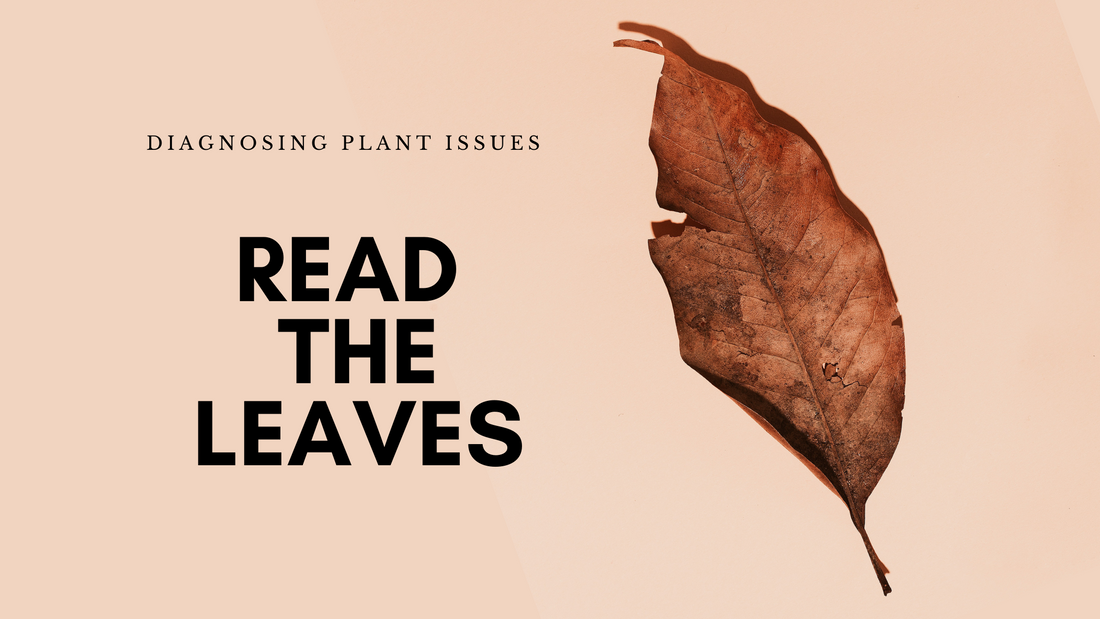
Your plants speak. No really! Though sometimes it might be a little difficult to understand what they are really trying to say, but a lot of times they exhibit some symptoms when they are stressed. All you need to know to understand the sign language of your plants is to observe them closely. Plants exhibit their stress symptoms mostly on their leaves. Yellow leaves, wilted leaves, spindly growth and a lot of other ways are how plants communicate with us.
Ready for some leaf lessons? Let go!
Wilted leaves

Diagnosis: The first reason for wilting of plant leaves might be water stress. Wilting of leaves might be mostly due to under watering or overwatering. Check the soil, if the top layers of soil felt dried when touched and the soil separates easily, then it is due to under-watering. If the soil feels damp and soggy and the basal leaves are mushy to touch, then it is due to overwatering. Excessive heat and very dry air can also cause the leaves to be wilted
Cure: Only water your plant when the top layers of soil feel dry to touch, Maintain consistent moisture throughout the blooming period but do not make the soil soggy. Mist your plants, when the air feels too dry.
Decayed leaves

Diagnosis: Decaying of leaves is mostly due to excess moisture on the foliage. Never over mist, your plants, do not make your foliage too wet while watering. Ensure that you mist your leaves in the morning instead of in the evenings so that the collected water in the crevices of the leaves have a chance to dry up before they catch fungal infections. On a general note, 50ml-80ml of water is enough to mist small to medium-sized plants while for larger and taller plants 100-150ml will suffice.
Cure: If your leaves are dusty, wipe them out with a wet cloth very gently once a week to remove the dust and improve transpiration. Along with the monitored watering in, the mornings greatly helps in keeping the foliage fresh.
Yellow leaves

Diagnosis: Yellowing of the leaves is mostly due to overwatering or nutrient deficiencies. Overwatering mushes the root leading the leaves to turn yellow. If the leaves are mushy or the soil is emitting a foul smell, then it is due to overwatering. If the older leaves are turning yellow, it is due to nitrogen deficiency and/or the plant is going through its natural lifecycle and dying.
Cure: Yellowing can be controlled via monitored watering. For indoor plants 2-3 times a week is enough for the plant to grow well; for flowering and outdoor sun loving varieties, always check the top soil dryness before watering. Use any well-balanced liquid fertilizers or nitrogen-rich fertilizers for soil or foliar application.
Interveinal chlorosis

Diagnosis: If the entire leaf turns yellow and the veins remain green, it is due to interveinal chlorosis. The interveinal chlorosis is due to iron deficiency.
Cure: Just apply iron-rich fertilizers in the form of foliar spray.
Dry Crispy Leaves

Diagnosis: Leaf drying is almost due to under-watering. Unless the season is extremely cold and the soil is not drying, try not to skip watering for longer than 4-7 days for indoor plants (except once a week watering varieties like Monstera, Palms etc) and 2-4 days for the flowering and sun sustaining varieties.
Too dry a soil repels water leading to a drier root ball and eventually the plant drying and withering off.
Cure: Always check the topsoil when you water your plants and make sure that the excess water is draining out of the drainage holes at the bottom of the pot.
Misshapen leaves
Diagnosis: The misshapen leaves are mostly due to biotic stress by pests. Aphids or thrips mostly causes abnormal sharpened leaves or disfigured leaves.
Cure: Use neem oil mostly @5ml per litre of water with some amount of liquid soap. You can also use insecticidal soaps.
Holes on your leaves

Diagnosis: Holes on leaves indicate the infestation by pests. Check the lower side of your leaves and folds of your leaves for larvae.
Cure: Use neem oil or Any insecticidal soaps as a control measure.
Powder marks on leaves

Diagnosis: Powdery mildew is mainly caused by the fungus Podosphaera xanthii. If you are observing some powdery masses or marks on your leaves, then it might be due to mildews.
Cure: Use sulphur based fungicides at lower concentrations.
Leaf spots

Diagnosis: Leaf spots might be due to fungus or bacteria. There is a very easy way to detect if your plant's leaves are infected by bacterial or fungal agents. Most of the bacterial leaf spots appear water-soaked and mostly angular whereas fungal leaf spots appear tan and yellow coloured and usually have concentric rings. There can be considerable browning as well around the infected parts.
Cure: Isolate the plant and remove debris and infected parts immediately and discard them. Sanitize all your gardening tools post using them for the trimming of the infected leaves. Use fungicides at lower concentrations to break the infection streak.
Need Help?
If you have any questions about your plants, you can chat with our Plant Experts to assist you with the same! (PS. you can reach out to our Plant Experts for pretty much any query related to your plants 😉)
Looking to add to your Plants collection? Check out our Free Plant Picker Quiz for some super-smart recommendations.



2 comments
Whenever I plant Hibiscus, the plant gets infested with mealy bugs.What should I use to get rid of mealy bugs?
What do I use to get the flowers to bloom bigger and healthy? What do I spray or use for orchids?